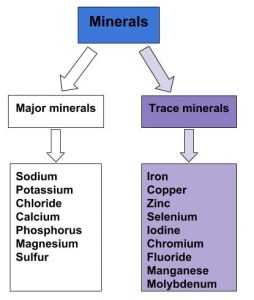Introduction
Li‘ili‘i ka ‘ō. hiki, loloa ka lua.
Small is the crab, large is the hole

Learning Objectives
By the end of this chapter you will be able to:
- Describe the functional role, intake recommendations and sources of trace minerals
Trace minerals are classified as minerals required in the diet each day in smaller amounts, specifically 100 milligrams or less. These include copper, zinc, selenium, iodine, chromium, fluoride, manganese, molybdenum, and others. Although trace minerals are needed in smaller amounts it is important to remember that a deficiency in a trace mineral can be just as detrimental to your health as a major mineral deficiency. Iodine deficiency is a major concern in countries around the world such as Fiji. In the 1990’s, almost 50% of the population had signs of iodine deficiency also known as goiter. To combat this national issue, the government of Fiji banned non-iodized salt and allowed only fortified iodized salt into the country in hopes of increasing the consumption of iodine in people’s diets. With this law, and health promotion efforts encouraging the consumption of seafood, great progress has been made in decreasing the prevalence of iodine deficiency in Fiji.[1]
Figure 11.1 The Trace Minerals

- Micronutrient Deficiencies. Ministry of Health and Medical Services, Shaping Fiji’s Health. http://www.health.gov.fj/?page_id=1406. Published 2015. Accessed November 12, 2017. ↵

